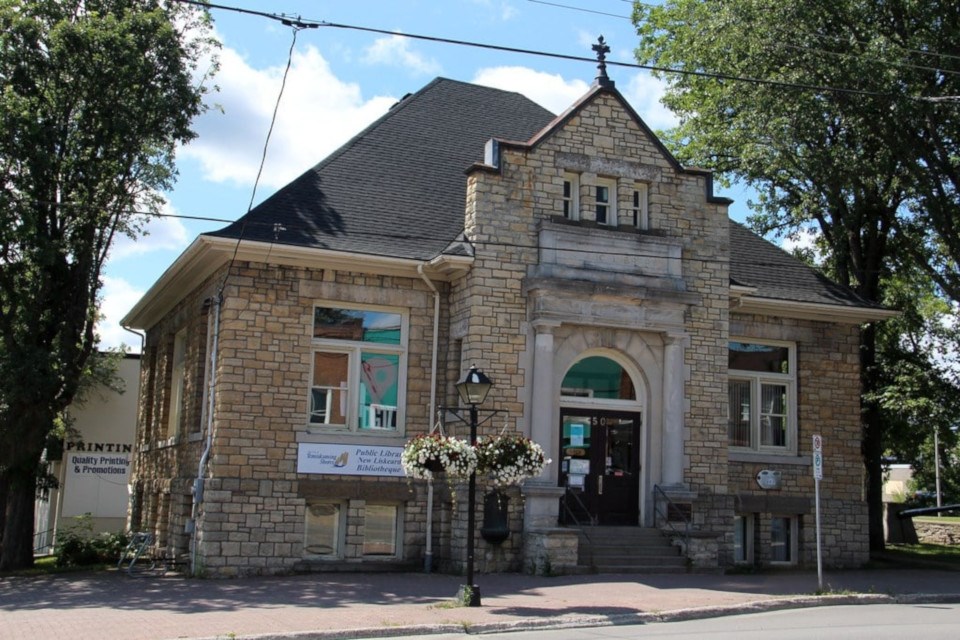When Ryan Primrose learned that the City of Temiskaming Shores had plans in 2019 to sell the building housing the New Liskeard library, the archaeologist vowed he would do whatever was needed to save the heritage structure.
Built in 1910, the 4,765-square-foot building is one of thousands of libraries around the world, including 111 in Ontario, constructed with funds from American industrialist Andrew Carnegie, who made his fortune in the steel industry in the late 19th century.
Turning to philanthropy later in life, Carnegie’s library endowment stemmed from his lifelong love of books and learning.
“A library outranks any other one thing a community can do to benefit its people,” he has been quoted as saying. “It is a never-failing spring in the desert.”
While many Carnegie libraries have been razed or dramatically altered over time, New Liskeard’s remains largely as it was built 110 years ago.
Designed by Angus and Angus architectural firm out of North Bay – the same firm that produced the Temagami train station – the library features 14-foot-tall ceilings, grand columns, and rich, polished wood trim.
All the limestone used in its construction was quarried from Burnt Island, located in Lake Timiskaming, just over the border in Québec, which later became known as Mann Island for the person who operated the quarry there.
“It’s an architectural marvel,” said Primrose, a principal at Woodland Heritage Northeast Inc. “I’d argue that it’s probably the most important building in the district.”
Concerned the building’s municipal heritage designation – bestowed by the town in 1984 – wouldn’t be strong enough to protect it from developers eager to score a key piece of downtown real estate, Primrose decided to put in a bid.
In the end, he didn’t have much to worry about: Primrose was the only bidder, with a purchase offer of $275,000. And, in late December, Woodland Heritage became the owner of its very own library.
Want to read more stories about business in the North? Subscribe to our newsletter.
Launched in 1999, Woodland Heritage undertakes archaeological consultations on a range of development projects – everything from mines to hydroelectric dams to cottages can require a government-mandated archaeological assessment before construction can move forward.
In his practice, Primrose has made it a priority to train and hire workers from the Indigenous communities in which he’s working.
That provides work for area residents, while also involving local Indigenous people with the discovery of their own history, he noted.
“It helps my relationship with the First Nations, and everybody’s always apprised of what’s going on,” Primrose said. “It just works out great for us, as well as the First Nations and my clients.”
Currently operating out of an 1,100-square-foot office down the street and around the corner from the library, Woodland Heritage won’t have far to go, come March, when Primrose takes possession of the building.
“It’ll be an easy move,” he joked. “All I’ll need is a conveyor belt.”
With more than quadruple the space he currently has, Primrose said the library will give Woodland more room to house and display artifacts, and set up its lab. He’s also fielding interest from potential tenants eager to rent a spot at the library.
The building is move-in ready, but Primrose has plans for the space.
A main goal is to return the library, as closely as possible, to its original condition.
That means removing layers of tile and carpet to reveal the hardwood floors and stripping years’ worth of paint from the wood wall panelling, reapplying a cream-coloured lacquer mimicking the 1910 hue. If he can track down the right archival information detailing species composition, he also wants to recreate the flower gardens that formerly bordered the building.
Otherwise, he said, the library is in great shape. A new roof and parapet have been applied in recent years, and minor damage caused by the weight of the books will be mitigated by their removal.
Eventually, he’s hopeful the Carnegie library can become home to the Ontario Centre for Archaeological Research and Education (OCARE), a passion project of his that aims to bring the wonders of archaeology to the public.
“One of the problems with archaeology is it’s interesting to almost everybody, but there’s a disconnect between the archaeological process – what I learn from the artifacts I recover – and what people have access to,” he said.
Primrose estimates he currently has 100,000 artifacts in his collection, which will eventually find their way to other institutions, including museums or Indigenous communities.
But in the interim, those pieces could be displayed on a rotational basis, and “the artifacts would then be able to tell a better story than from sitting in a box,” he said.
“I think it would be great if people and school groups could come in and check all that out.”
The nascent not-for-profit is just getting off the ground, but ideally, Primrose would secure charitable status for OCARE, which would then raise enough funds to purchase the building and secure provincial heritage status. Woodland Heritage would then become a tenant.
But that part of the plan is still in the future, he noted.
In the meantime, he’s just happy to breathe sigh of relief knowing the building will be preserved for future generations to enjoy.
“It was designed as a public space, and we want to continue using it as a public space,” he said. “As well, we wanted to ensure the protection of it.”




